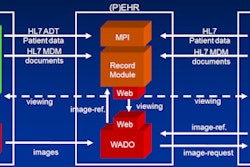
NEW YORK (Reuters Health), Apr 6 - Concomitant chemoradiation is better than sequential therapy for improving survival with locally advanced non-small cell lung cancer (NSCLC), according to a patient-level meta-analysis reported online March 29 in the Journal of Clinical Oncology.
The improvement comes at the cost of increased, but manageable, acute esophageal toxicity, the researchers say.
Lead author Dr. Anne Auperin from Institut Gustave-Roussy, Villejuif, France, and colleagues note that in most individual trials, adding sequential or concomitant chemotherapy to radiation led to improved survival in patients with locally advanced NSCLC.
To directly compare the sequential and concomitant approaches, the investigators conducted a systematic search for published and unpublished trials. They identified seven randomized trials and requested the data on all patients: gender, age, date of randomization, treatment assignment, performance status at randomization, tumor stage, histopathology, and updated information on survival, recurrence, cause of death, and acute toxicity.
Ultimately, their meta-analysis included data from six trials involving 1,205 patients (92% of all randomized patients in the seven trials). The median follow-up was six years and was similar in all the reports.
In the survival analysis (based on 1,068 deaths), simultaneous radiochemotherapy conferred an absolute survival benefit of 5.7% at three years (23.8% versus 18.1% for concomitant versus sequential, respectively) and 4.5% at five years (15.1% versus 10.6%, respectively).
Similarly, progression-free survival was better with concomitant treatment (16.0% at three years, 11.6% at five years) than with sequential treatment (13.1% at three years, 9.4% at five years).
Locoregional progression was less frequent with concomitant radiochemotherapy, but there was no significant difference between the groups in rates of distant progression (based on data from five trials with roughly 1,100 patients).
"As expected," the authors say, "there was an increase of acute esophageal toxicity in the concomitant as compared with the sequential combination arm. However, this rate was relatively low and clinically manageable." Eighteen percent of patients who received concomitant therapy had grade 3 to 4 esophageal toxicities, compared to 4% of patients who had sequential therapy (relative risk, 4.9).
The two strategies did not differ in rates of acute grade 3 to 4 pulmonary toxicity. The researchers could not evaluate grade 3 to 4 hematologic toxicities because rates varied too widely.
"Considering the survival benefit of more than 5% at three years, concomitant radiochemotherapy should now be the reference treatment for locally advanced NSCLC," the authors conclude.
They add, "It is important to note that this type of treatment is generally proposed for selected, fit patients with minimal comorbidities."
J Clin Oncol 2010.
Last Updated: 2010-04-06 11:59:10 -0400 (Reuters Health)
Related Reading
Adaptive radiation therapy monitors tumor change, December 25, 2009
ASTRO: Use PET for NSCLC judiciously, November 3, 2009
Copyright © 2010 Reuters Limited. All rights reserved. Republication or redistribution of Reuters content, including by framing or similar means, is expressly prohibited without the prior written consent of Reuters. Reuters shall not be liable for any errors or delays in the content, or for any actions taken in reliance thereon. Reuters and the Reuters sphere logo are registered trademarks and trademarks of the Reuters group of companies around the world.



















